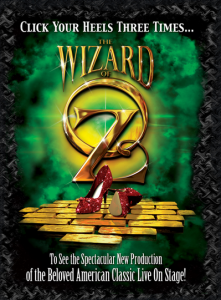
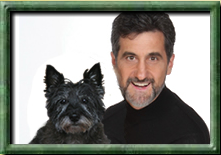 Don’t miss “The Wizard of Oz” when it comes to St. Louis, for a limited engagement staring Friday, November 26 through November 28. I had the chance to talk with Bill Berloni, founder of William Berloni Theatrical Animals, who did the training for Toto in the show – as well as most of the animals in Broadway shows that run today.
Don’t miss “The Wizard of Oz” when it comes to St. Louis, for a limited engagement staring Friday, November 26 through November 28. I had the chance to talk with Bill Berloni, founder of William Berloni Theatrical Animals, who did the training for Toto in the show – as well as most of the animals in Broadway shows that run today.
Kevin: How long have you been involved with training dogs for theatre, and other forms of entertainment?
Bill: For about 34 years. The first dog I ever trained was the original Sandy in the original production of “Annie.” I was 19 years old at the time, and I’ve pretty much done all the Broadway shows since Annie in 1977 that have had animals.
K: You didn’t actually start off as a dog trainer right? You were an actor?
B: You could say that. I had just graduated high school, and was going to college to become an actor. So those were my dreams and aspirations. I was apprenticing at a theatre called the Goodspeed Opera House, and it was a place where they did the original production of “Annie.” They needed a dog trainer, and they couldn’t afford it, so they offered me a part in one of the shows if I would find and train a dog for free. And so that’s how I got involved. Because there was no money for the trainer or anything, I went to an animal shelter. I heard they had cheap dogs at the pound, and that is where I found the first Sandy.
K: So before that, you didn’t have any aspirations to become a dog trainer?
B: Yes, that’s true.
K: Wow, it’s obviously turned into this whole career and all these amazing opportunities. That’s really neat how that happened. After you trained the first dog, how did you decide that you wanted to keep training?
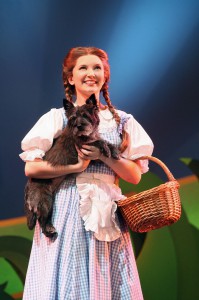 B: Well, I went to New York, and we did the Broadway company. I was still under the allusion that I was going to be studying acting, and doing the show at night… then they asked me to train dogs for the road companies of “Annie.” There were four of them, and I started rescuing dogs to do that.
B: Well, I went to New York, and we did the Broadway company. I was still under the allusion that I was going to be studying acting, and doing the show at night… then they asked me to train dogs for the road companies of “Annie.” There were four of them, and I started rescuing dogs to do that.
Probably about two years later, after my third Broadway show – I was asked to do two more Broadway shows – I realized I was much more talented as an animal trainer than I was as an actor. And I made that my profession.
K: I saw on your website that you have a lot of different animals that you use. Are those your personal pets, or do they belong to other trainers that you work with?
B: All the animals that I own – we adopt them from animal shelters –we keep them whether the shows run or not. We do own 21, as three of the dogs that are not up there would not be performers. They all live on a farm with us. It takes a real high level of training to get an animal to perform on stage.
K: How many other people do you have training with you.
B: We have one assistant, and 5 or 6 trainers on the road.
K: How does the training process you perform compare to me going to get my dog trained for obedience?
B: There really isn’t any difference. The difference is that when you train an animal to listen to you in your home or around your neighborhood – that is where they do it. We just have to de-sensitize them to all of the distractions that they would encounter in a theatrical production.
You know, people will see Sandy, people will see Toto, people will see Bruiser from “Legally Blonde.” They will go, “wow, what a great dog.” But anybody could have walked into a shelter and adopted them the day before I did. Yes, they are very special – but it’s the way that you train them and handle them that makes a difference.
K: I saw “Legally Blonde” at the Fox earlier this year. That dog was so well behaved, and appeared to the audience to do everything he was supposed to do.
B: Thank you.
K: Now, there is a huge difference between being around 10 people, and 4,000 people and lights and other things around a theatre. Are there specific methods that you use to keep the dogs focused while performing?
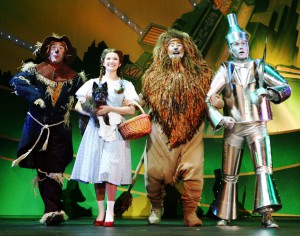 B: Well, it all goes to my philosophy of animal training. Remember, I didn’t start out wanting to be an animal trainer. I was a kid who had a dog, and loved it and took care of it. I was an only child, and grew up on a farm, so I was very close with my dog. It did things for me because it loved me, and wanted to be with me.
B: Well, it all goes to my philosophy of animal training. Remember, I didn’t start out wanting to be an animal trainer. I was a kid who had a dog, and loved it and took care of it. I was an only child, and grew up on a farm, so I was very close with my dog. It did things for me because it loved me, and wanted to be with me.
So when I was given the assignment to train Sandy, I didn’t know about negative reinforcement. I didn’t know anything about what dog trainers do. And it was a live theatre production. With my dog, every time you opened the drawer to get the can opener to open the dog food, he would come running – no matter where he was. So I knew they could do things consistently, with all sorts of distractions. So it was like, how could I create the situation where they would want to do it every night? And that’s the secret to my success.
Most animal trainers in the world work on some sort of negative reinforcement. If you don’t do this – there is a consequence. You know, the Dog Whisperer and all that sort of stuff. Being the alpha dog, and creating a situations where the dog becomes almost afraid not to be perfect. Well guess what? None of us are perfect. So, We all make mistakes – but it’s not OK for our dogs to make mistakes.
When I design to the shows, I create a situation where the actors we work with our trainers. The animals love them – they are bonded to them. When I let them go on stage, they’re doing behaviors that they know if they do them right they’re going to get love, attention – and some sort of reward. And with that, they’re unflappable. And when they do make a mistake, the actors are trained to guide them through the right behaviors. And then they don’t get the reward. The extent of the negative reinforcement is that they don’t get the reward if they don’t do it. If it’s clear to them, and they feel safe, they will do it every night. And that’s really the secret. Again, most pet trainers do this thing where if they don’t do it, there’s some sort of negative consequence.
If your dog wants to do something for you – it doesn’t matter where you are, or what’s going on – they will do it. If a dog came on stage with its ears back or its tail between its legs, and you are forcing it to work (dogs unfortunately will work for humans if they are frightened of them), you would be able to tell that. Where as, it made perfect sense to me when I was young that my dog would do things for me because he loved me. So why couldn’t I recreate that situation on stage. That’s really how we look at it.
It all goes back to being a part of the creative process. Sitting down with directors and writers, saying “we need this,” and I’ll help guide them through the way that it will work.
K: While the actors are on-stage, performing in a show, are they the ones giving them treats?
B: Well again, I was being trained in theater so I thought it would be silly if the dog was on-stage, had to look off stage to get a command, and execute it. He’s supposed to belong to the characters, so part of the training is that we work with actors and turn them into actors. They are responding to the characters they’re supposed to be responding to in the story.
K: How did this opportunity to work on “The Wizard of Oz” come about?
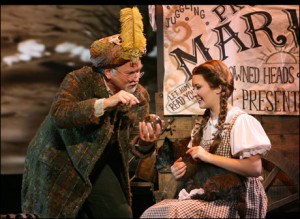 B: Gosh, I’ve been doing “The Wizard of Oz” for about 20 years now. I did the Broadway production back in the early 90s. It’s just one of the staples of shows that we do. Four years ago, this touring group approached me about doing “The Wizard of Oz” – this is the fourth year of the tour.
B: Gosh, I’ve been doing “The Wizard of Oz” for about 20 years now. I did the Broadway production back in the early 90s. It’s just one of the staples of shows that we do. Four years ago, this touring group approached me about doing “The Wizard of Oz” – this is the fourth year of the tour.
K: When someone is looking to have an animal trained for a show, you are kind of the guy to go to – right?
B: Yes, for live theater – which is a real honor. I mean, I love doing movies. Movies to me are simple, because you can yell, “quiet on the set.” You only have to get it right once, you know? You can control the environment and all that sort of stuff. The other entertainment trainers who do movies and television have tried to do the work that I do and have not been successful at it. So, I sort of remain to be the go-to-guy for these sort of events.
K: It sounds like you are always are working on training, but is there a specific amount of time you can say it takes a dog, like Toto, to be comfortable in a role?
B: It usually takes 6 months from the time we get them out of the pound, until they are ready to start rehearsals. Once you’ve seasoned them, and they’ve been on-stage in front of an audience, then it’s just teaching them how to do it in different productions.
The two dogs in this show did it last year, so they know exactly what to do. We have a new Dorothy this year, so we’ve been working on that.
K: During the actual show, has anything unusual or funny ever happened?
B: As a theater professional, the audience loves when things go wrong on stage. I think it’s very important to focus on the play, and not cracking up the audience. Again, they’re going to make mistakes. Humans make mistakes. But the actors know what to do in case the animal gets off track.
I mean, in 34 years we have never had an animal go to the bathroom on stage. Where it gets dicey is if an actor doesn’t give the commands correctly. The dog can’t go, “oh, they blew the cue. I’ll cover.” The dog goe
s, “oh, they didn’t give me the command. Let me go to the trainer,” and they will walk off stage. So the times in which the actors have failed to do their jobs, the animal has walked off stage and it looks like the animal is acting out.
In this production, you know, it snows during the poppy scene. Sometimes the snow lands on the dog while it’s sleeping and it starts eating it. That sort of stuff. In some theaters, the audience is closer to the stage than in others. People in the front row will distract the animals and that sort of stuff. All in all, nothing glaring.
K: How would you compare the training in this show to others, like in “Annie” for example?
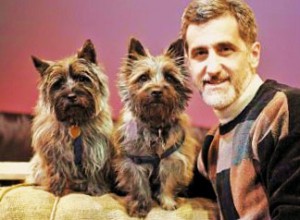
B: “The Wizard of Oz” is the biggest role for an animal in a live theater event. In “Annie,” you see him in the beginning of the play and you don’t see him until the end. In “Legally Blonde,” the dog is just in 6 scenes. Toto – our expectation is that everywhere you see Toto, you see Dorothy. The dog is in a lot of scenes. It may not be doing a lot, but just being on-stage and being still – people forget that we train the dogs not to steal focus. Even though Toto is on-stage, it can’t be wondering around. It can’t be licking itself, or following stuff. The challenge is keeping them still in all of the scenes.
Particularly, when you see the show, having the dog perfectly still when she’s singing “Somewhere Over the Rainbow” is hard to do. In my mind, that’s the most important behavior in the show. You hear that song, and you remember Judy Garland. If the dog is distracting us, you are robbing the audience of their experience.
K: Do you have a favorite part of working on “The Wizard of Oz” over all these years?
B: Well, as a person in their 50s, ‘Wizard of Oz’ was our “Star Wars.” It was our “Harry Potter.” It was the fable of our time. For me, it always just reminds me of my childhood memories. Bringing it back and keeping it alive for new generations is great.
K: About how many shows at a time will you work on?
B: Sometimes 3 or 4 at one time will be running around the country. We have the tour of ‘Blonde’ out, the tour of ‘Oz.’ We have an “Annie” running in Long Beach, California. There is an “Annie” here. In two weeks, I’ll be setting up “The Wizard of Oz” up in Vermont. So we do regional theater productions all over the place.
K: Any new movies or television work coming up, or are you primarily just working on live theater right now?
B: We just wrapped a film this summer… called “Someday This Pain Will Be Useful.” It starred Allan Burston, Marsha Gayharden, Lucy Liu, one of the kids from ‘Harry Potter.’ One of the main characters has a dog, so it was one of our dogs. That’s in post-production right now. We do the animals for Jimmy Fallon’s show, and we do the animals for Sesame Street. Fashion ads, and that sort of stuff. Being on the East Coast, we don’t do a lot of movies and television.
For more information about Bill and William Berloni Theatrical Animals, visit the official website at theatricalanimals.com.
“The Wizard of Oz” will grace the Fox Theatre stage from November 26-28! For more information and to purchase tickets, visit fabulousfox.com or MetroTix.com!
